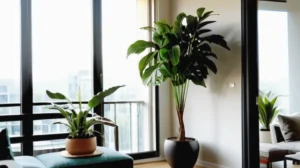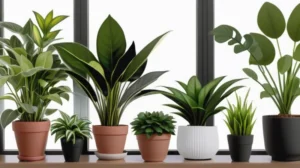The Importance of Indoor Plants for Air Quality in Apartments
In the hustle and bustle of modern life, we often overlook the quality of the air we breathe, especially within the confined spaces of our apartments.
We’ll explore the sources of indoor air pollution, the health implications of poor air quality, and actionable steps to improve the air you breathe within your apartment.
Table of Contents
Understanding Plant-Based Air Purification
We often think of plants as just aesthetic additions to our homes, but many varieties can actually help purify the air we breathe indoors. With concerns over indoor air quality and the prevalence of volatile organic compounds (VOCs), it’s worth exploring how plants can be powerful natural air purifiers.
Plants work to clean indoor air through the process of photosynthesis. As part of this process, the tiny pores on plant leaves (stomata) take in carbon dioxide and release oxygen. But plants don’t just remove CO2 – their leaves also absorb other gaseous pollutants like benzene, formaldehyde, and trichloroethylene which are commonly found in household products, paints, and furnishings.
Within their root microbiome, plants also harbor beneficial bacteria that break down and neutralize some of these VOCs into less harmful byproducts that can then be absorbed. Additionally, the microorganisms in the potting soil aid in removing indoor air pollutants as well.
Some plants are simply better at this air-purifying process than others. Varieties like English ivy, peace lilies, snake plants and golden pothos aresome of the best air purifying plants.
With their high transpiration rates and robust root structures, these plants excel at filtering out VOCs and other airborne toxins.
By strategically placing a few of these air-purifying plant heroes throughout your home, you can continually detoxify the indoor environment and improve the quality of air circulating in your living spaces. Just be sure they receive adequate sunlight, water, and nutrients to thrive.
Beyond removing VOCs, plants have also been shown to reduce other indoor air pollutants like carbon monoxide and nitrogen dioxide while increasing humidity levels. Adding greenery is a simple way to freshen up your indoor breathingspaces!
Top 5 Plants for Small Apartment Spaces
Living in a small apartment doesn’t mean you have to miss out on the air-purifying benefits of houseplants. In fact, many of the best air purifying plants are perfectly suited for compact spaces. Here are the top 5 varieties to consider for your city digs:
Snake Plant
The snake plant’s upright, architectural leaves make it an ideal floor plant that takes up very little square footage. It’s one of the most low-maintenance options, able to thrive in low light and with infrequent watering.
Pothos
With its trailing vines, the pothos is a beautiful hanging or shelf plant that adds greenery without taking up prime real estate. It’s exceptionally easy to care for and one of the top air purifiers according to NASA studies.
Chinese Evergreen
This low-light tolerant plant has a compact, upright growth habit perfect for placing on tabletops and shelves. Its stiff, oval-shaped leaves help remove indoor toxins.
Peace Lily
While it needs more light than some other varieties, the peace lily’s broad leaves and air-purifying prowess make it worthwhile. Plus, its white flowers add a nice decorative touch.
English Ivy
An ivy hanging basket is an excellent way to reap this plant’s air-cleaning abilities while dressing up an empty wall or corner. Just be sure to let the soil dry between waterings.
Plant Care
No matter how tight your square footage, there are plenty of smart plant picks to freshen up your apartment air! Focus on low-maintenance, compact varieties for the biggest purification bang for your buck.
| Plant | Light Needs | Watering Needs |
|---|---|---|
| Snake Plant | Low-Medium | Infrequent |
| Pothos | Low-Medium | Moderate |
| Chinese Evergreen | Low-Medium | Moderate |
| Peace Lily | Medium-High | Frequent |
| English Ivy | Medium-High | Frequent |
4. Care Tips for Indoor Plants in Apartments
Keeping indoor plants thriving in an apartment setting can be tricky due to limited space and lighting.
But with the right care tips, you can ensure your leafy roommates stay happy and healthy!
Here are some key considerations:
- Choose Low-Light Tolerant Varieties
Many apartments don’t get a ton of natural light. Opt for indoor plant varieties like Snake plants, Pothos and Chinese evergreens that can tolerate low-medium light conditions. - Water Properly
Over-watering is a common issue for apartment dwellers. Always check soil dryness before watering and ensure proper drainage. Under-watering is also stress-inducing for plants. - Boost Humidity
Heating and AC systems can dry out indoor air. Mist plants regularly, use pebble trays, or get a small humidifier to increase ambient humidity levels. - Fertilize Regularly
Confined root-bound plants need nutritional boosts. Feed every 2-3 months in spring/summer with a balanced liquid fertilizer diluted to half-strength. - Prune and Rotate
Prune off dead growth and periodically rotate plants toward their light source to prevent lopsided growth. - Check for Pests
Common houseplant pests like spider mites, mealybugs and fungus gnats can proliferate indoors. Inspect plants regularly and treat infestations promptly.
With some simple strategies tailored to apartment living, it’s totally possible to cultivate an indoor oasis! The mental health benefits of greenery are well worth it.
5. Maximizing Benefits: Positioning and Number of Plants
Where you place your indoor plants and how many you have can significantly impact their air-purifying capabilities.
To fully reap the benefits, strategic positioning and achieving the right plant density are key factors to consider.
- Place plants in rooms you occupy most Situate your plants in the main living areas like the bedroom, home office, or family room where you spend the majority of your time indoors. The more exposed you are to the plants, the more air purification you’ll experience.
- Distribute throughout the home Don’t just cluster plants in one room. Dispersing them around helps circulate and filter air in all areas of your home or apartment.
- Group plants together While distributing is ideal, grouping a few plants together can also help amplify their air-cleaning effects through condensation and transpiration.
- Follow the 1 plant per 100 sq ft rule For optimal air purification, NASA recommends 1 plant per 100 square feet of home or office space. More plants equals more filtering potential.
- Prioritize bedrooms We spend around a third of our lives sleeping, so bedroom plants are crucial for removing airborne irritants that get trapped overnight.
- Avoid bathrooms and kitchens
High humidity and cooking emissions can damage plants over time, diminishing their air purifying abilities. Stick to other living spaces.
With some smart positioning and enough plant density, you can truly maximize the fresh air and toxin-removal qualities that houseplants provide.
Don’t be afraid to bring the outdoors in!
7. Conclusion: Greening Your Small Space for Health
By strategically positioning and having the right density of these plants throughout your living spaces, you can maximize their air-cleaning benefits.
The key is to place plants in the rooms you occupy most, distribute them around your home, group them together when possible, and follow the recommended ratio of 1 plant per 100 square feet.
The first step is to pick out a couple of the highlighted varieties and position them in your main living areas or bedroom. With some simple care like proper watering, humidity, fertilization, and pest monitoring, you’ll be well on your way to purifying the air you breathe indoors.
Resources
THE 9 BEST LOW-LIGHT PLANTS FOR YOUR HOME OR OFFICE
https://www.swansonsnursery.com/blog/the-9-best-low-light-plants-for-your-home-or-office
22 Best Indoor Plants for Any Room
https://www.goodhousekeeping.com/home/gardening/advice/g1285/hard-to-kill-plants/





